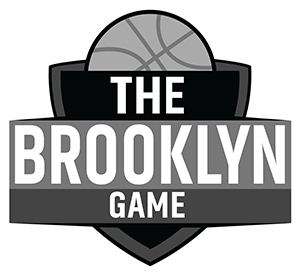
On Sunday night, the Boston Celtics abused the Brooklyn Nets on the glass, collectively out-rebounding them 50-42, with only a late push closing that gap within single digits.
After the game, Lionel Hollins admonished his team for a lack of toughness. “You gotta hit first,” Hollins said about his team’s issues on the inside, with center Mason Plumlee his key target.
He acknowledged that Plumlee “didn’t play poorly,” but also said that “we need… a primary rebounder, and with (Brook Lopez and Kevin Garnett) out, I was hoping he would come out and show a big splash on the glass.” Plumlee finished with just four rebounds in 21 minutes, one fewer than Joe Johnson.
Plumlee responded in a big way, grabbing 17 rebounds against the assorted collection of human men contractually obligated to wear a Philadelphia 76ers uniform. But can he keep it going?
History says: probably not.
The Nets ranked as the second-worst rebounding team in the NBA last season, grabbing only 47.1 percent of available rebounds, well below the league average of 50 percent and only better than the Los Angeles Lakers. Returning Brook Lopez, a gifted player with few rebounding instincts, projects the Nets as an even worse rebounding team this year.
Rebounding requires a particular blend of physicality, effort, and intuition. It’s a trait that strongly correlates between the NCAA and NBA: if you’re a great rebounder in college, chances are you’ll be a great one in the NBA. Just ask Denver Nuggets forward Kenneth Faried, who averaged 14.5 rebounds per game in his senior season at Morehead, tumbled to the end of the first round of the NBA Draft, and earned a spot on the USA Men’s National Basketball Team thanks to his rebounding acumen and boundless energy.
But Plumlee, a fellow 22nd overall pick, hasn’t had the same success on the glass. He never cracked 10 rebounds per game in college, topping out at 9.9 in his senior year in just under 35 minutes per game. He grabbed 14.5 percent of all available rebounds in his rookie season, an average-at-best number for a center.
Historically, it doesn’t look good. Using Basketball-Reference‘s tools, I put together a “Plumlee scale,” ranking rookie forward-centers that had roughly Plumlee’s numbers: 21 to 24 years old, at least 1,000 minutes played, and a rebound rate between 14 and 15 percent.
Of the 20 players that fit the scale who weren’t rookies last year, only one became a particularly great rebounder: 2006’s #1 overall pick Andrew Bogut, who earned the moniker after a career year in Golden State last season. (Hall of Fame center Patrick Ewing also made the list, but he was known as a great all-around center and scorer more than a tenacious rebounder.) The players on average became worse rebounders after their rookie seasons, and only a few showed real improvement after their first season:
That by itself doesn’t mean that Plumlee won’t improve as a rebounder. If anything, it only bolsters the idea that he should: the guys that got worse tended to do so as they either tumbled out of the league or became more perimeter-oriented players, and neither seems likely for the upwards- and inwards-trending Plumlee.
He’s also got some solid-if-not-spectacular rebounding tools. He isn’t long: he’s one of the few NBA players that measures a shorter wingspan than height and he’s got a shorter standing reach than the 6’8″ Luol Deng, but he makes up for it with a 36-inch vertical and an eager second bounce. His game is a perpetual dive towards the paint when he’s not setting screens, and he gets most of his rebounds by sneaking around opposing big men and bounding towards loose balls.
But he’s got a lot of growing to do. Out of an even 100 players last season who played in at least 60 games and had at least eight rebound chances per game, Plumlee ranked 93rd in conversion rate, grabbing just 51.9 percent of potential rebounds, according to the NBA’s SportVU optical tracking data. Plumlee also corralled only 1.8 contested rebounds per game, a low number for a paint-dominant center even when adjusted for playing time. If he’s got box-out position he can hold it, but Plumlee was often out-muscled in the paint for close rebounds, and unless he snared the ball high off the rim at the apex of his jump, he was often in for a struggle.
(For comparison, former Nets center Andray Blatche ranked in the top 50, grabbing 60.6 percent of potential rebounds. This is not to criticize the Nets for cutting ties with Blatche, who had garnered such a reputation as a headcase around the league that he didn’t even get one minimum NBA offer. Just to give some context to the numbers.)
Work ethic and a willingness to listen have been Plumlee staples since he played at Duke, and it’s those mental traits that helped him earn a rotation spot in Brooklyn last year. Hollins will ride him to get stronger, and he should; even though Hollins’s former prodigy Gasol didn’t improve as a rebounder, he improved enough on defense to earn the league’s Defensive Player of the Year Award in 2012-13, and Hollins was a factor in that progression.
Even if he doesn’t improve substantially on the glass, Plumlee is still a positive, thanks to DUNKS! and a willingness to run the floor. But players also don’t morph into rebounders overnight, and given Plumlee’s career trajectory, it’s hard to imagine him suddenly becoming a better rebounder after a couple of lectures about toughness. With this team begging for one more rebounder, can Plumlee buck the odds?

















